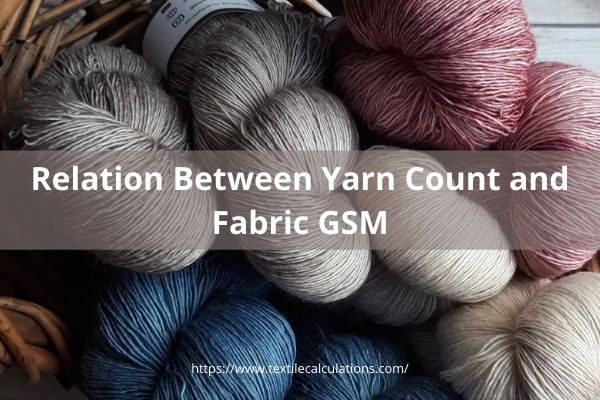What is Yarn Count:
Count is a numerical value, which expresses the coarseness or fineness (diameter) of the yarn and also indicate the relationship between length and weight(the mass per unit length or the length per unit mass)of that yarn. Relation Between Yarn Count and Fabric GSM is very important to a textile professional.
To become a successful textile personnel one must have out-and-out knowledge on yarn count and fabric gsm systems. This is one of the first and foremost basics that one might possess to survive in the textile industry. The best weaving loom and knitting machines require yarns of appropriate yarn count. At the end of this article, you will have a clear concept.

GSM: The GSM of fabric is one kind of specification of fabric which is very important for a textile engineer for understanding and production of fabric. ‘GSM’ means ‘Gram per square meter’ that is the weight of fabric in gram per one square meter. By this, we can compare the fabrics in the unit area which are heavier and which is lighter.
It is the metric measurement to check the weight of the fabric. GSM value is dependent on the kind of fabric – Cotton, wool, polyester, etc. The fabric GSM is directly proportional to the thickness of the fabric. As the value of gsm increases, the thickness increases as well. GSM is not restricted to fabric alone. To calculate the GSM of fabric or paper means to measure their thickness.
Relation between Yarn Count and Fabric GSM:
The relationship between yarn count and fabric GSM (Grams per Square Meter) is inversely proportional. In general, the higher the yarn count, the finer the yarn, and the lower the fabric GSM, and vice versa.
The relation between count and GSM of different fabrics are given below:
A. Single Jersey:
- 130-150→ 30’s
- 160-170→ 26’s
- 180-200→ 24’s (210)
- 220-240→ 20’s
B. P.K./Lacost/1×1 Rib:
- 150-170→ 34’s
- 180-200→ 30’s
- 210-225→ 26’s
- 230-250→ 24’s
- 250-270→ 20’s
C. 2×1 Rib:
- 220-230→ 30’s
- 240-250→ 26’s
- 260-280→ 24’s
D. Interlock:
24 G -22 G
- 40’s→ 220 – 200
- 34’s→ 250 -230
- 30’s→ 260 -240
- 26’s→ 275 -260
E. S/J with Lycra 5%:
- 150-160→ 34’s
- 170-190→ 30’s
- 200-210→ 26’s
- 220-240→ 24’s
F. Fleece:
- 250→ 20,30’s (Ratio 20:80)
- 300→ 10, 26’s (Ratio 30:70)
Author of this Article: Rana Sohel B.Sc. in Textile Engineer Cell: +8801912-420118


It's too important to know. Thanks…
Your post is superb. Thanks for sharing us updated information.
I am extremely inspired with your writing abilities as smartly with the format for your blog.
thaks 4 what
Dear,
Thanks a lot to share this.